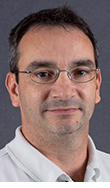EA Sports’ graphics supervisor joins Viz faculty at Texas A&M

André Thomas
André Thomas, who led graphics development, planning and implementation for the EA Sports’ powerhouse lineup of football videogames since 2007, is now passing his considerable game industry knowledge to visualization students as a lecturer at Texas A&M.
“His work at EA was at the highest end of graphics realism and interactive environments and characters,” said [Department of Visualization] (http://viz.arch.tamu.edu/) head Tim McLaughlin.
In Thomas’ three classes this spring, students are learning about game design, game development and creating digital environments.
An expert in digital content creation and software development with more than 20 years of experience in all aspects of computer-generated imagery, Thomas led a multidisciplinary team of software engineers, graphic artists and project managers at EA Sports, making yearly improvements to EA’s [Madden] (http://www.easports.com/madden-nfl) video game, what Rant Sports calls the industry’s most successful sports video game franchise, and the rest of EA’s football lineup: [NCAA Football] (http://www.easports.com/ncaa-football) , [Head Coach] (http://www.ea.com/nfl-head-coach) , NFL Tour and [NFL Arcade] (http://www.ea.com/madden-arcade) .
Before he joined the faculty, Thomas made regular visits to Texas A&M as a longtime member of Visualization Industry Partners, the department’s advisory board, telling students what they’d need to know for a career in the video game industry.
“He lectured about lighting and materials, user-interaction design and what it takes to get a job today and be prepared for a career developing the next generation of games,” said McLaughlin.
Thomas is also contributing to interdisciplinary game-related research at Texas A&M including:
- Designing an interactive, online supplement for art history classes that will include game methodology;
- Exploring the possibility of using gaming technology and MRI scan data to develop a virtual environment for veterinary students to practice animal surgery; and
- Working with the university’s nautical archaeology program to develop an interactive, online database of seagoing vessels throughout history, cross-referenced with population movement and changing shipbuilding methods.
Tags
Related Posts
NSF group melding art, science learning

Initiative fusing arts, technology education gains momentum

Pixar Viz alumnus enlightens students with technical skills
Follow Us
Facebook Twitter Vimeo Youtube Flickr RSS
Recent Posts

Planning prof heads study of disaster housing aid

A message from the dean

Former student remembered as expert planner

Leading educator named new head of Architecture Dept.








_thumbnail_small.png)
